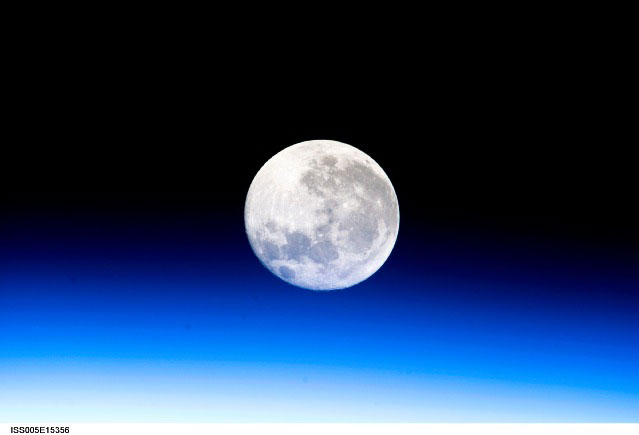
[Find out when is the next blue moon.]
New Year's Eve brings us the second of two full moons for North Americans this month. Some almanacs and calendars assert that when two full moons occur within a calendar month, that the second full moon is called the "blue moon."
The term has a very interesting history, riddled with misconceptions and errors. More on that lower down. First, what will (and won't) happen:
The full moon that night will likely look no different than any other full moon (other than the fact that a partial eclipse will occur across most of Europe, Africa, and Asia).
But the moon can change color in certain conditions. After forest fires or volcanic eruptions, the moon can appear to take on a bluish or even lavender hue. Soot and ash particles, deposited high in the Earth's atmosphere, can sometimes make the moon appear bluish.
In one example, smoke from widespread forest fire activity in western Canada created a blue moon across eastern North America in late September 1950. In the aftermath of the massive eruption of Mount Pinatubo in the Philippines in June 1991 there were reports of blue moons (and even blue suns) worldwide.?
Get the Space.com Newsletter
Breaking space news, the latest updates on rocket launches, skywatching events and more!
The phrase "Once in a blue moon" was first noted in 1824 and refers to occurrences that are uncommon, though not truly rare. Yet, to have two full moons in the same month is not as uncommon as one might think. In fact, it occurs, on average, about every 32 months. And in the year 1999, it occurred twice in a span of just three months!
For the longest time no one seemed to have a clue as to where the "blue moon Rule" originated. Many years ago in the pages of Natural History magazine, I speculated that the rule might have evolved out of the fact that the word "belewe" came from the Old English, meaning, "to betray."
"Perhaps," I suggested, "the second full moon is 'belewe' because it betrays the usual perception of one full moon per month."
But as innovative as my explanation was, it turned out to be completely wrong.
More mistakes
It was not until the year 1999 that the origin of the calendrical term "blue moon" was at long last discovered. It was during the time frame from 1932 through 1957 that the Maine Farmers' Almanac suggested that if one of the four seasons (winter, spring, summer or fall) contained four full moons instead of the usual three, that the third full moon should be called a "blue moon."
But thanks to a couple of misinterpretations of this arcane rule, first by a writer in a 1946 issue of Sky & Telescope magazine, and much later, in 1980 in a syndicated radio program, the second full moon in a month is the one that's now popularly accepted as the definition of a "blue moon."??
This time around, the moon will turn full on Dec. 31 at 2:14 p.m. Eastern Standard Time (11:14 a.m. Pacific Daylight Time).
But for those living in central and eastern Asia, as well as Australia and New Zealand, that same full moon occurs after midnight, on the calendar date of Jan. 1, 2010. So in these regions of world, this will not be second of two full moons in December 2009, but the first of two full moons in January 2010. So, if (for example) you live Perth or Tokyo, you'll have to wait until January 30 to declare that the moon is "officially" blue.
Eclipse for some
This week's full moon will also undergo a partial eclipse.
The moon will dip slightly into the Earth's umbra ? the dark, hard-edged shadow ? which will show black or dark brown on the moon's southern limb for just over an hour; this will be a pre-midnight New Year's Eve show for Europe, Africa and western Asia, while for central and eastern Asia, Indonesia and western and central Australia this will happen in the post-midnight hours of the first day of 2010. Maximum eclipse will come at 19:23 UT, when just 8.2-percent of the moon's diameter is within the umbra.
Unfortunately, most of North America (except for northern Alaska and northernmost Canada) is out of the zone of visibility for this eclipse.
The last time a blue moon coincided with New Year's Eve was in 1990. The next opportunity will come in 2028.
- Partial Eclipse New Year's Eve
- Top 10 Amazing Moon Facts
- Gallery: The Moon
Joe Rao serves as an instructor and guest lecturer at New York's Hayden Planetarium. He writes about astronomy for The New York Times and other publications, and he is also an on-camera meteorologist for News 12 Westchester, New York.
Join our Space Forums to keep talking space on the latest missions, night sky and more! And if you have a news tip, correction or comment, let us know at: community@space.com.

Joe Rao is Space.com's skywatching columnist, as well as a veteran meteorologist and eclipse chaser who also serves as an instructor and guest lecturer at New York's Hayden Planetarium. He writes about astronomy for Natural History magazine, Sky & Telescope and other publications. Joe is an 8-time Emmy-nominated meteorologist who served the Putnam Valley region of New York for over 21 years. You can find him on Twitter and YouTube tracking lunar and solar eclipses, meteor showers and more. To find out Joe's latest project, visit him on Twitter.









